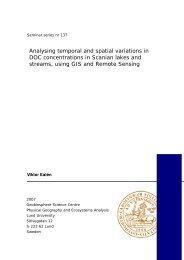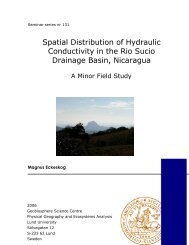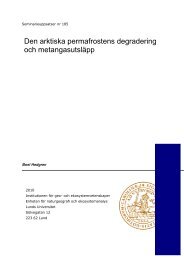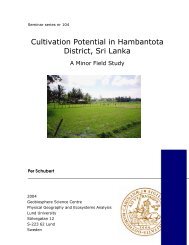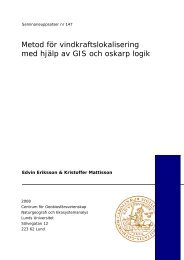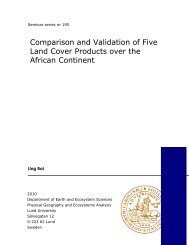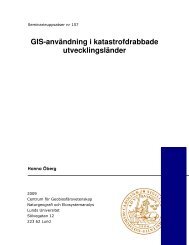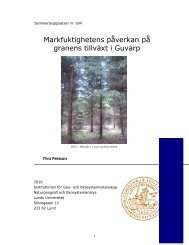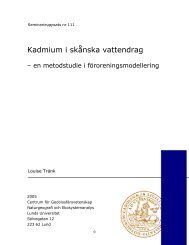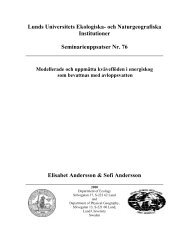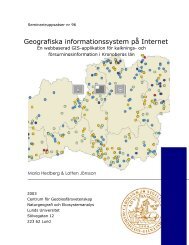Finding Potential Sites for Small-Scale Hydro Power in Uganda: a ...
Finding Potential Sites for Small-Scale Hydro Power in Uganda: a ...
Finding Potential Sites for Small-Scale Hydro Power in Uganda: a ...
Create successful ePaper yourself
Turn your PDF publications into a flip-book with our unique Google optimized e-Paper software.
4.2.6 Post Process<strong>in</strong>g of Output DataThe result at this stage conta<strong>in</strong>s numerous potential sites <strong>for</strong> small-scale hydropowerthat, <strong>for</strong> different reasons, are <strong>in</strong>accessible or unusable. To exclude these areas weapplied a mask-grid on the algorithm-output by us<strong>in</strong>g the ArcGIS raster calculatorfunction. The mask-areas are:o National Parks – derived from the Land use layer. The national parks areprotected areas, mostly conta<strong>in</strong><strong>in</strong>g tropical ra<strong>in</strong><strong>for</strong>ests.o Electrified areas – derived from the Adm<strong>in</strong>istrative layer. These areas arerepresented of major towns. They are already connected to the exist<strong>in</strong>g grid andare there<strong>for</strong>e <strong>in</strong> no need of small-scale hydropower.o Surround<strong>in</strong>g Countries – derived from national borders <strong>in</strong> the Adm<strong>in</strong>istrativelayer. A number of potential sites are situated <strong>in</strong> the neighbor<strong>in</strong>g countries,because the geographical <strong>in</strong>put data exceeds the borders of <strong>Uganda</strong>.4.3 Evaluation of <strong>Potential</strong> <strong>Sites</strong>When the GIS-analysis was f<strong>in</strong>ished, the result had to be evaluated <strong>in</strong> order to determ<strong>in</strong>ethe quality. The evaluation was per<strong>for</strong>med dur<strong>in</strong>g three weeks <strong>in</strong> the study area, cover<strong>in</strong>gapproximately 3000 square kilometres. Due to the <strong>in</strong>ability to unh<strong>in</strong>dered visit all sites <strong>in</strong>the terra<strong>in</strong>, we decided to evaluate sites <strong>in</strong> vic<strong>in</strong>ity of roads and smaller villages. Weestimated to be able to evaluate at least 25 sites. Due to our economic situation, thepossibility to travel with a 4X4-car was excluded; <strong>in</strong>stead we used a small Ch<strong>in</strong>ese-mademotorcycle.The purpose of the evaluation was to validate that the result co<strong>in</strong>cides with reality. Thiswas done by controll<strong>in</strong>g a) that the stream had a head of at least 20 meters over adistance of 100 meters and b) that there was a permanent flow <strong>in</strong> the stream. To furtherestimate the power potential of the site, we measured the flow of the stream.4.3.1 Head MeasurementsTo validate the required head of 20 meters over a distance of 100 meters, we used ahand-held sight<strong>in</strong>g meter (see Figure 4.11). They are often called <strong>in</strong>cl<strong>in</strong>ometers or Abneylevels and can be accurate if used by an experienced person, but it is easy to makemistakes and double-check<strong>in</strong>g is recommended. Because they are small and hand-held,the error will depend on the skill of the user, but will typically be between 2% and 10%.44



